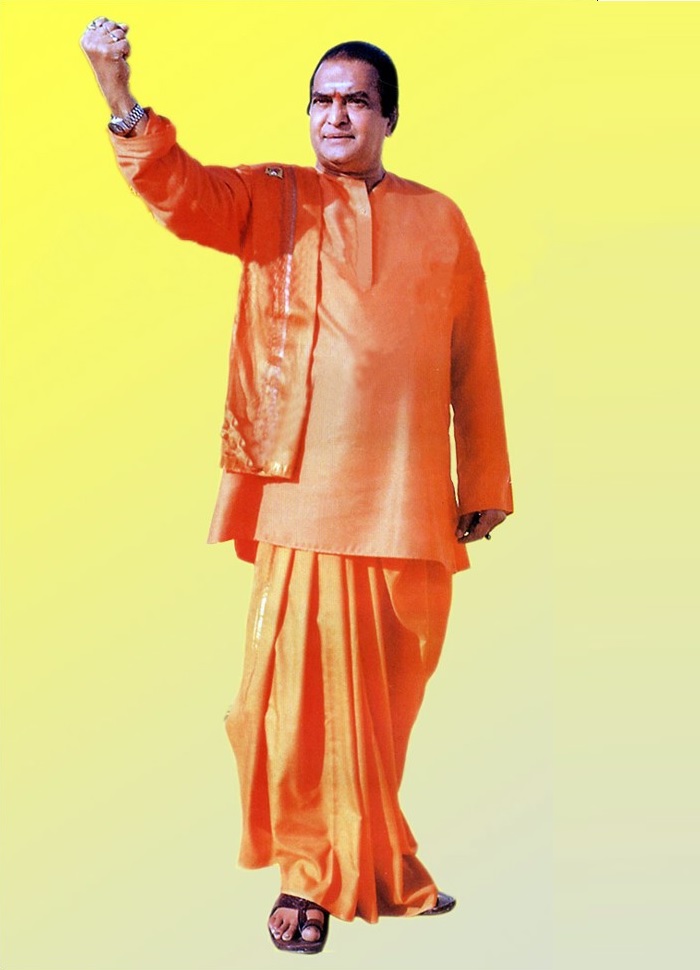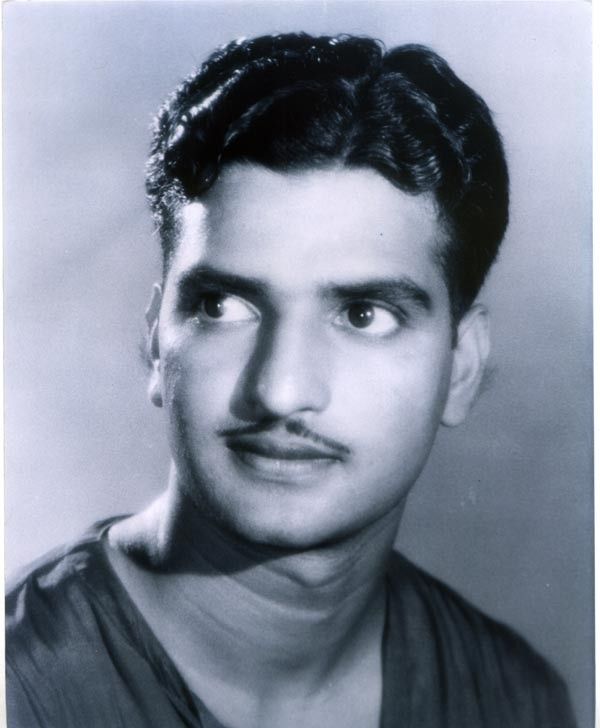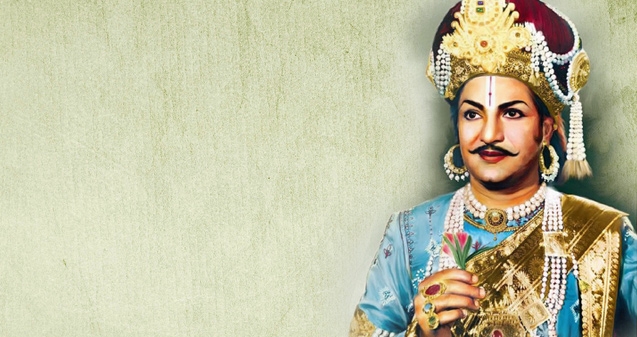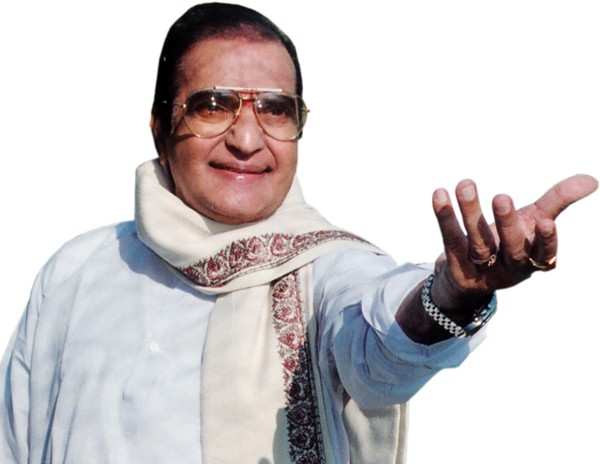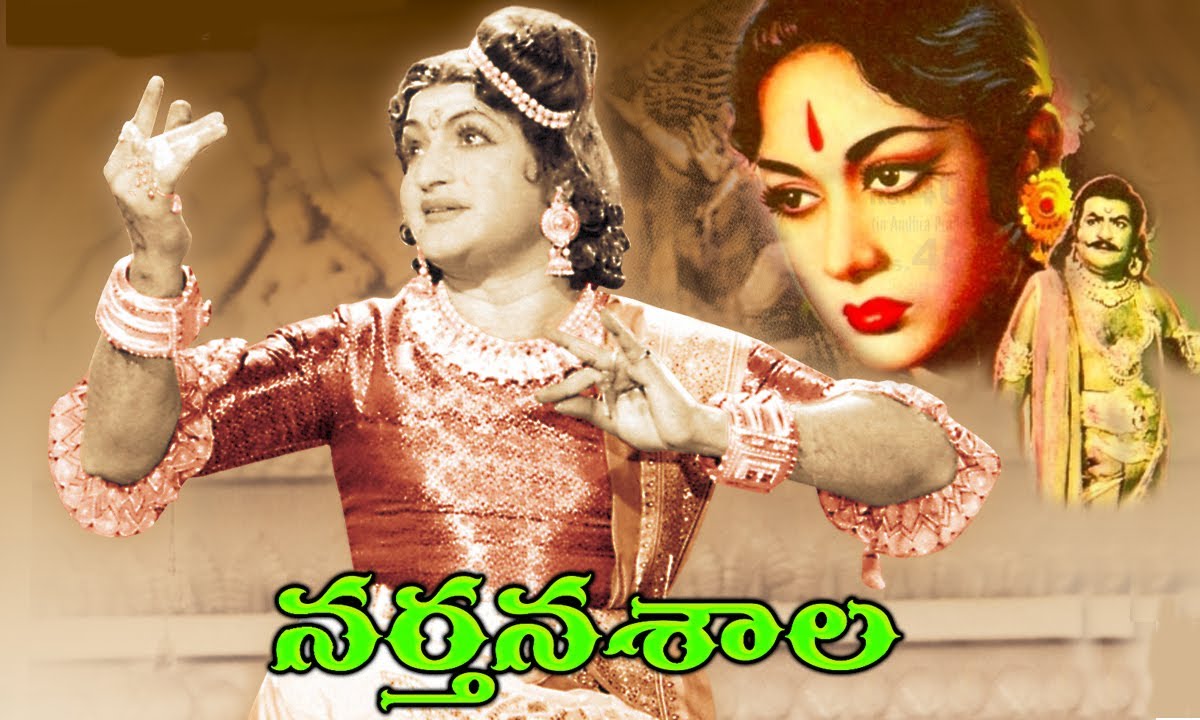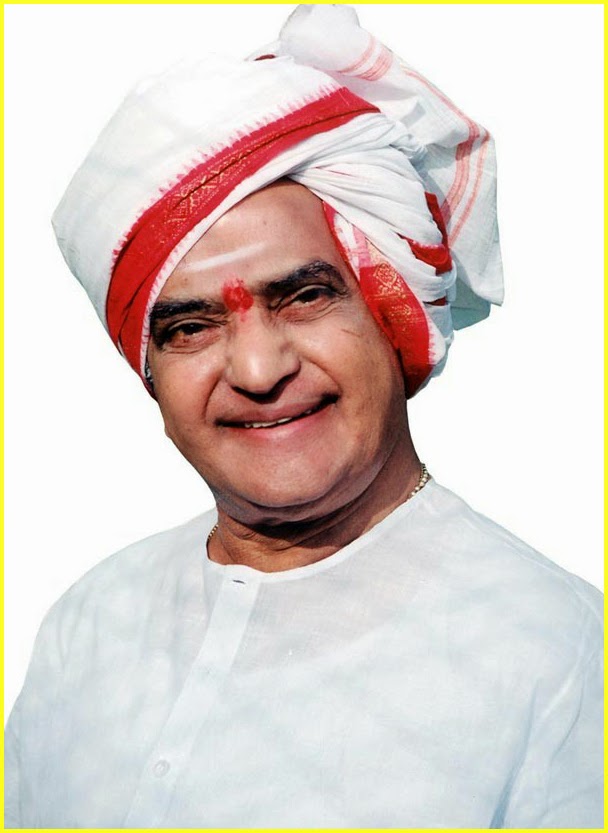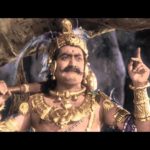Those of you following us on twitter may have been reading our recent tweets on Self-Respect. It is a word that is often used by rowdies for all the wrong movements. But self-respect is something greater than self-glorification. Self-respect is fundamentally about respecting yourself by respecting others. After all, a gentleman behaves properly around ladies (no matter what their character), not because of what it says about them, but because of what it says about him.
One such gentleman was celebrated for not only the characters he portrayed on screen, but the character he showed on the political stage. In fact, our very own Chandra Mohan garu wrote on the topic and the man here. Though we will build upon this theme, we will focus more on the biographical, cinematic, and political aspects of his place in history.
Few men in their lives (and after) can be recalled by the masses with simple initials: NTR is one such man.
While Sri Nandamuri Taraka Rama Rao garu may have passed away 2 decades ago, his life and legacy, in cinema and in politics, touches every Telugu to this day.
If any actor ever put the mythos in a mythic career, it was the man who defined it and defined “Mythology” in the minds of the Telugus. That is why he is the topic of today’s installment in our Continuing Series on Andhra Personalities.
Background
Born in the village of Nimmakuru, Krishna District, on May 28, 1923, NTR hailed from an agricultural family of modest economic background.His parents were Venkataramamma and Laxmaiah. Due to the customs of the time, he was adopted by his childless paternal uncle Ramaiah and his wife. After completing class 5, young Rama Rao had to matriculate in Vijayawada to complete primary, and secondary studies. He later enrolled in SRR and CVR colleges. In a twist of fate, his first play was written by the head of the Telugu Department at his College, Kavi Samrat Viswanatha Satyanarayana. The drama was a progressive piece on women’s issues in Rachamalluni Dautyam. In those days, society was very conservative and ladies did not act in plays. The famously masculine ‘man of the masses’ was made to play (reluctantly) the heroine’s role…an experience which would later come in handy in Narthanasala, no doubt!
Nevertheless, the consummate thespian, NTR played the role to perfection and won first prize. This gave him the taste for theatre, which he would later bring to the silver screen.
From his early days of youth itself, he was a breadwinner for the kutumbam, selling milk on his bicycle to help the household make ends meet.
At the age of 20, he married Basava Tarakam. However, he had yet to complete his studies, and thus, had a difficult time succeeding in his examinations, given this new responsibility as a householder. He finally succeeded in passing out of Andhra Christian College in Guntur, with a Bachelor of Arts, in 1945. He also founded the National Art Theatre, a drama group. He later met the famed director L.V.Prasad. This chance meeting was a taste of things to come, and would play a pivotal role in his career.
In the mean time, however, the demands of supporting a family meant that he had to take up a job. He passed the Madras Service Commission examination and was given a job as sub-registrar. This minor post was not to his liking, and he was stunned upon seeing the open bribery taking place.
Nevertheless, he had cultivated a booming baritone signing voice, and was blessed with good looks and broad shoulders. Deciding to chase his destiny, he quit his job and resolved to make a career in films.
From his first part, a walk-on as a police officer in Mana Desam (1949), for which he was paid 500 rupees (today about pounds 10 sterling), he became one of the cinema-crazed state’s best-known idols. [4]
A mere three weeks into his job, his photo was picked out of L.V.Prasad’s album by B.A.Subba Rao, for the hero’s role in Palleturi Pilla. This would launch the most legendary of all Telugu film careers.
The list of films ,of course, is endless. While Palleturi Pilla was itself a super hit, due in no small part to NTR’s refusal to have a stunt-double for his bull-fighting scene (he was hospitalised after being thrown by it), it was Paathala Bhairavi that would launch him into the stratosphere. So successful was this blockbuster, that it would later be made in other languages.
But, it was Maya Bazaar, of course, that would seal this screen legend’s place in Cinema-dom. Virtually living in the role of Sri Krishna, NTR’s acting here would set a trend of divine performances (pun intended) that would forever mark his place on the psyche of the Telugus. So scintillating was he in these pauranic roles, and so synonymous with these puranic stories, that many village and towns folk would touch his feet in divine association, in a way only seen since for actors of Ramanand Sagar’s Ramayan and B.R. Chopra’s Mahabharat. Such is the power of Cinema—something NTR would leverage for his second career, in his second innings.
Fittingly, and indeed, very politically, his last movie before entering politics in 1982 was Bobbili Puli. It would serve as the ideal segue and launch pad for him into politics. The film released on his Sashtipoorthi (completion of 60 years), with the Telugu Desam Party, the party he founded, marking its formal entry into politics on the same day. He grandly seized power in a landslide election victory in 1983. Though ousted in a coup the following year, he returned quickly with an even greater mandate.
Closer to home, NTR ultimately had six sons and four daughters from his marriage. The most famous of his progeny is of course, the silver screen star Balakrishna (set to appear soon as Gautamiputra Satakarni). However, the son who would have the most impact on him politically would be the one by marriage, who took over the leadership of the Telugu Desam Party. As is notoriously recounted elsewhere, there were family dissensions in the last few years of Rama Rao garu’s life. His first wife passed away in 1984. He remarried, and this time, it was to his erstwhile political biographer, Lakshmi Parvati in the early 1990s. Family politics being what they are, the grown children did not take kindly to the political changes that accompanied the personal changes. Together with NTR’s son Harikrishna, Nara Chandra Babu Naidu took over the leadership effectively in a takeover bid, and would go on to carve out a notable legacy as CM of old & new Andhra Pradesh state.
Without judgment of either side, this turn of events (whether warranted or otherwise) had a traumatic effect on NTR, who felt betrayed. True to his indomitable spirit, he planned a comeback, but Mahakaal had other plans. The celebrated Movie star, State Political leader, and National Political figure had his final innings. He passed away on January 18, 1996, at the age of 72. A lifelong practitioner of yoga, he credited it for his longevity and energy.
Achievements
The manifold achievements of this man of the masses, have faded with the passage of time. Perhaps it is time we remind the younger generation of why NTR’s name carries so much pull to this day, on both sides of the Polavaram.
His cinematic achievements are obvious, and indeed will be discussed in greater detail later in the Post. If they could be summed up in a phrase, however, it was performing High Culture for the masses. It was theatre on the silver screen that was accessible to educated and illiterate and young and old alike. Indeed, in the early phases of old AP, where there was some mistrust among the three regions of Andhra (Kosta, Rayalaseema, and Telangana), whatever differences cropped up due to history, evaporated when this screen legend appeared as the divine and historical personalities revered by all Telugus alike.
But he was a trend-setter not only in Cinema, but also in politics. The first Rath Yatra was done not by LKA, but by NTR. His ‘Chaitanya Ratham’ would conduct a yatra throughout the state, even finding him a place in the records books, marking 75,000 kms in less than a year.
When he first hit the road with it in 1982, soon after founding the party, the vehicle was an object of ridicule by the Congress. But criss-crossing the length and breadth of the State on the ‘chariot of awakening,’ with the theme song of Telugu self-respect on his lips, he was able to rouse the masses and defeat the ruling Congress. The election was a landmark in the country’s political history, as NTR stormed to power within nine months of founding his party defeating a century-old party.[6]
By the time the elections had come around, this modern Chariot and this modern Andhradesadeeswara managed to rouse popular rebellion against these modern sultans of Delhi. Rather than paeans to the decadent Nehru-Gandhi Netas of Congress, in its place sounded, Maa Telugu Thalli, throughout the state.
“For months, the ‘Chaitanya Ratham’ trundled along the lush green paddy fields of coastal Andhra Pradesh, the dry landscape of Rayalaseema and Telangana and through the busy thoroughfares of the towns. “[6]
For those who thought NTR managed to merely “coast” to victory on the back of his celebrity, they clearly missed the lessons on political groundwork he gave them, free of charge. It was this campaign, this ratha yatra that garnered him the popular support and credibility to gain power. It demonstrated, as some recent film stars-turned-politician can attest, that his election was no fluke. But his political achievements go beyond political innovation. Here is a quick recap for readers:
- “In all, he acted in 292 films in a career spanning 33 years between 1949 and 1982. Of these, 274 are in Telugu, 15 in Tamil and three in Hindi.” [3]
- Awarded the Padma Shri in1968. 3 National Film awards. 1 Nandi Award
- Was instrumental in shifting the Telugu Film Industry from Madras to Hyderabad. This along with his life-long devotion to his mother tongue helped restore the distinct identity of the Andhras.
- Pushed for decentralisation of governance through Mandal elections. Began restoring traditional Telugu-Sanskrit terms from colonial Nizam-Persian terms.
- Took on and crushed the fundamentalists in Old City Hyderabad, making this Capital of Telugus from the Days of Golkonda, safe for all citizens.
- Introduced mid-day meal programme for children of impoverished families. Later copied in 7 other states.
- He reserved more university places and expanded primary education for Women.
- Implemented the Telugu Ganga Project in Rayalaseema, together with support of Sathya Sai Baba, quenched the water thirst in the region.
- Ended the oppressive Patel-Patwari system of the Nizam era in Telangana
- After Starring, Directing, and Producing films, also began Screenwriting films. Notably wrote Samrat Ashoka in 1992
- Adorned the Tankbund with great figures from Telugu History.
What happened to those statues he gave us, today?
Legacy
The illustrious legacy of NTR remains concrete to most, but nevertheless, controversial to many. A beloved personality, so widely revered by villages and urbanites alike, necessitates historical understanding, objectively.
With any popularly honoured figure, so synonymous with a modern culture, it becomes as important to understand the man beyond the hagiographies and diatribes alike. Political opponents refuse to compliment him and political fanboys…well…commit suicide over him (as one did when he passed away).
Nevertheless, the legacy of NTR to the Telugu land is hard to gainsay. Economically sound or not, his 2 rs/kg rice programme saved thousands upon thousands from starvation. Questions of nepotism aside, he forged a coherent countervailing influence to the corrupt Congress. Snide remarks of parochialism aside, his Telugu atma-gauravam campaign restored self-respect for Telugus at a time when it had reached a low point. Nothing was more emblematic of the sea-change in the Telugu Restoration he initiated in the capital of the Telugus, by enforcing through Law Enforcement, the implementation and protection of Official Telugu signboards in Hyderabad from urdu-language fanatics. Golkonda of the Kakatiya era was the capital of Krishna-Godavari Samskruthi, not the geographically non-native Ganga-jamuni “tehzeeb“.
Above all however, both on screen and off, he reminded Andhras that they were not mere colonised people of the British Raj, but the inheritors of the Empire of Krishna Deva Raya. No man more poignantly and poetically demonstrated the relationship between Art & History, Cinema & Politics. Let us do a retrospective of his roles.
Cinematic
Unlike the self-promoting but culturally barbarous “bollywood” (of modern middle eastern orientation), the Telugu Film Industry has promoted real native Bharatiya Samskruthi in all its glory. This tradition reached its noontide under Nandamuri Taraka Rama Rao. While the period that followed his golden years in the Golden Age of Telugu cinema was not altogether free of caste critiques of closed doors, the quality of films in his era did not suffer, as it did in later periods. The films of NTR were High Culture for the Masses. They demonstrated that it was possible to create meaningful and mature films for even illiterate audiences . If we had Gidugu Ramamurthy garu for Literature, we had Nandamuri Taraka Rama Rao garu for Cinema. False dichotomies of stilted inaccessible vs crass cruditude were no longer required. The full spectrum from granthikam to mandalikam to janapadam, could be enjoyed, only if presented with taste and aesthetics. This mantle, after a long hiatus, has been taken up again by director S.S.Rajamouli.
These matters not withstanding, having taken a look at the man behind the films, let us take a look at the movie mogul in his films.
It’s of course difficult to pinpoint a single scene, a single movie, or a single set of movies as definitive of the body of work an artiste has contributed to the body saamskruthik, but there are a few standouts not only for cultural purposes but for career purposes as well. The first such movie is the popular Paathala Bhairavi. Arguably the first blockbuster in a long and illustrious career, this was NTR’s first true contribution to the long list of cultural significant films he produced.
A romantic hero, a lover, and a fighter, the character he played was in truth, the Telugu every man. This 1951 hit made waves not only in both Telugu states (unification would be a long 5 years later…) . What was praiseworthy about it was how it was based off the native Burrakatha tradition of Telugudom. But if any one scene truly embodies the subtleties that are often missed in the grandeur of Taraka Rama Rao Senior, it is this.
Maya Bazaar
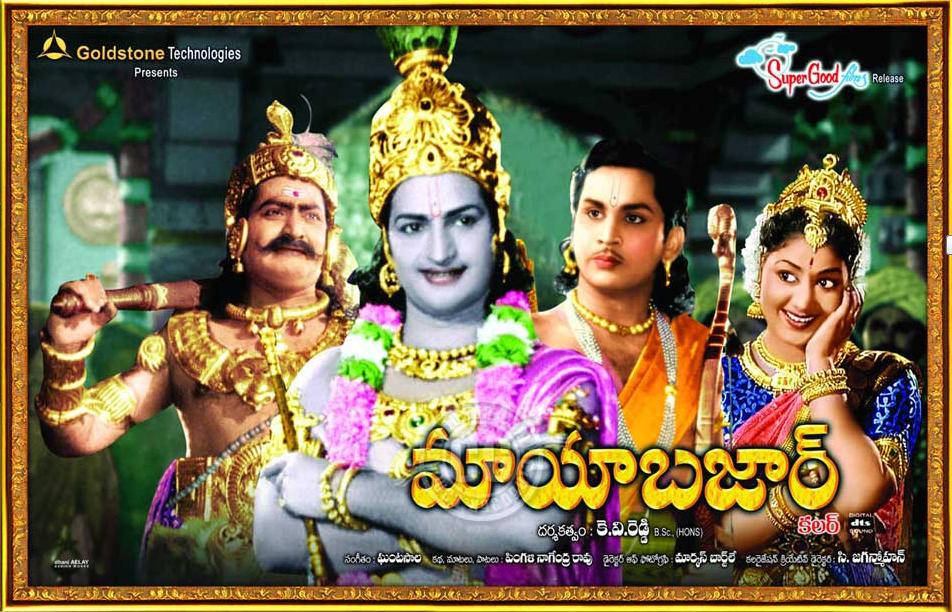
For all the incipient greatness of Paathaala Bhairavi, it was Maya Bazaar that forever etched NTR in the hearts of Telugus. Appearing in the first of what would eventually be 17 appearances as Lord Krishna, it was this cinematic Rayudu’s most popular role.
The execrable modern attempts to create almost an androgrynous Krishna would be firmly rebuked with a single screening of the “Ranchod” portrayed by Rama Rao. Indeed, NTR’s Kannayya gave us the statesman and strategic thinker, rather than than the traditional young flute-player or philosophic Gita-giver. It was a serious Krishna, that nevertheless, lost none of the provocative charm and coy uplifting inspiration.
One would make juxtaposition with the much later, and nationally-recognised Nitish Bharadwaj, but my Telugu credentials would stand impeached, so NTR it is…

Arguably one of his most sensitive roles, it also showed that, in contrast to the decidedly modern “eve-teasing” and general street harassment of women courtesy Bollywood, lotharios of a different era had a more genteel and courteous approach to women, even when being playful.
In contrast to this era of narcissism and solipsism as strategy for social success, NTR’s character here showed how restrained charm, and manly sensitiveness, along with boyish playfulness, go a longer way for would-be Kamadeva’s even in our era. Indeed, his character found himself the object of affection of not only Missamma herself, but Jamuna’s character as well!
This scene nevertheless captures his unique ability to project a confident yet approachable and self-aware masculinity on screen. It was not loud and brash, but cultured and self-mastered.
Narthanasala
Last but not least, it was this movie, more than any other, that showed us NTR the acting professional, rather than merely NTR the star. His full depth and range was seen in this production. His turn in the role of Brihannala (Arjuna’s identity during the Pandavas’ agyatavasam) was genre-defining. This was all the more so given the fact that he learned dance from none other than the eminence grise of Kuchipudi himself, Sri Vempati Chinna Satyam garu.
Of course, there are many, many more movies that could be pored over, and indeed, will be. Nevertheless, here are a few other standouts.
Other Notable Filmography
Tenali Rama Krishna
Mahamantri Timmarasu
Srinadha Kavi Sarvabhouma
Sampoorna Ramayanam
Sri Venkateshwara Mahatmyam
Bobbili Puli
Political
With three terms as Chief Ministers Rama Rao garu had as long-lasting a legacy in politics as he did in films. Each time he would be voted out of office, he would return to power with landslide victories. Indeed, in his final days, he had hoped to do the same, but Destiny decided otherwise.
From breaking the oppressive Patel-Patwari system of the Nizam to giving a firm rebuke to the Gandhi dynasty and its Congi cronies, NTR is synonymous with one thing: Self-Respect. But his was not a crass “self-respect” that singled out a single caste or a set of “settlers” for slander, it was a self-respect that brought people together rather than divide them up. Did he cater to his base?—sure, like any sharp politician does. The question is, did his actions and policies benefit the state as a whole?
True Atma-gauram lies not in “licking the ones who kick and kicking the ones who lick”, but giving a black eye to those who push you around and protecting those who can’t protect themselves. That is the difference between a poodle and a purusha. The ethos of Nandamuri Taraka Rama Rao reminded us precisely of that Nara-tattvam and that Telugu Atma-Gauravam and that Andhra Abhimanam. One can be a good local citizen, a good state citizen, a good national citizen, and a good cultural denizen. NTR represented all four.
He firmly stood up to the presiding national leader who over-stepped his bounds, to show Telugus could not be pushed around. It did not matter what the caste was of T.Anjaiah whom Rajiv Gandhi insulted, what mattered was his mother tongue. The only jati that mattered here was the Andhra jati.
He crushed the fundamentalists from Old City Hyderabad, and helped reassert the place of Golkonda as an old capital of the Telugus. This is true atma-gauram. This ended the communal riots during Ganesh Nimmajan. And yet from the days of NTR and CBN (who finally tamed them), here is the state of the new state today.
He, significantly, chaired the National Front, a left-leaning alliance, that served as a counterweight to Congress. At the height of his popularity, NTR was thus deemed Prime Ministerial material, and had luck ultimately favoured, he may have succeeded—such were the shadows he cast in those days. Nevertheless, the opportunity did not fructify, and instead, true to his legacy, he promoted the candidacy of the first South Indian and first Telugu Prime Minister, Sri Pamulaparthi Venkata Narasimha Rao garu. Though the relations between PVNR and NTR would ebb-and-flow, there was a common bond of Teluguthanam, that, whatever their differences, united them. Rama Rao garu even refused to field an opponent against the future PM, for the Lok Sabha seat.
As such, perhaps the most telling description of all came from his sometimes political rival, and a man he himself nevertheless supported.
The prime minister, Narasimha Rao, described him as “a man of many parts – a learned and deeply religious person, a very fine and powerful actor who swayed millions of people, a forceful orator and above all, a man of the masses.”[4]
But for all of Telugudom, NTR was more than just “a very fine and powerful actor“, but a reel and real-life superstar who not only defined Andhra Cinema, but became synonymous with the Divine Stories it once told. To this day, he set a cultural standard that Telugu film is only again beginning to rediscover in both depth and grandeur. The statues still being constructed of him, confirm this story.
While his administration was not free of caste-conflict, notably two key episodes standing out (Vangaveeti Ranga and the Violence at Karamchedu), to blame NTR directly would be as unfair as blaming PVNR for the Babri Riots. Politics is complicated, and whatever role caste plays in it today, it only emphasises the need for us to focus more on Rajdharma than just Rajniti. Political leaders are also products of their time, and such matters are better left for historians to research more deeply.
For the purposes of Andhra Cultural Portal, however, the cultural contribution of this man is what stands out the most.
Cultural
The cultural impact of Nandamuri Taraka Rama Rao cannot be minimised. This is for the simple fact that he was the thespian who brought High Culture to the Masses. Rather than looking down upon the mamidi manishi, and churning out mindless drivel for box office collections, he told us stories that defined the genre: Maya Bazaar, Missamma, Paathaala Bhairavi, Narthanasala, Bhookailas, the list goes on and on for films that not only gave us entertaining stories, but that lifted our spirits and intellects.
Even religion was dealt with a tasteful manner, not with the blaring of instruments, but with the touching of the soul. It was this deft weaving of the nava rasa and dhvani that gave never-ending resonance to his political message. Populist though he was, there was a dharma to his dharna.
Many may of course point to various corruption charges. But even the great PVNR was not immune to these allegations, and politics in India has in recent centuries, truly been a grimy business. What’s more, as one can see with a certain political party in the State of Delhi, and even outside the country, more often than not, accusers often have grimier hands that the accused.
Others of course bring focus to NTR’s second wife and her political involvement in his waning days, others may point out to gossip of numerous love affairs. But men of power have always had powerful appetites, and have been hurt by them in the process. Whether the rumours of the silent coup on the inside are as true as the overt rebellion from his family on the outside, is a matter for historians to resolve. But if one criticism can be made of NTR, it’s that he, like other politicians from Bhishma to L.K.Advani, should make succession plans and retire at the right age.
Along with this cultural legacy, was a familial one. Family matters aside, his name carries on today with not only his sons, but his Grandson and namesake NTR junior, and even the son of first Chief Minister of new Telangana state. Such is the stamp of “Taraka Rama Rao”, literally.
And to return to matters full circle, while one should aspire to the legacy of Ram, the question ultimately is what good was done for the people, state, and culture.
NTR’s achievements, both political and cultural speak for themselves. Above all, however, the measure of a man is not whether he alternates between tyrant and sycophant. A real leader doesn’t beat up on the weak while slinking away before the strong. He stands up to the strong and defends the weak, as he did during Indira Gandhis regime. That is true self-respect. Ahankar and Ego take pride in flattery, braggadocio, and bullying. Real leaders show us the real meaning of atma-gauram. Not complaining about settlers who are your language brothers, but recognising the perils posed by persian-language promoting videshi colonists. Not emotionally combusting at slights and provocations, or last minute last stands, but harnessing man power and organising people power for the common good, consistently. That is real atma-gauram.
It was NTR who showed how to be a good regional leader and a good national leader. It was NTR who showed the real meaning of class: aristrocracy not of distant royalty, but of an accessible and courteous and cultured gentry. To neither take for granted our state and mother tongue, but to also not neglect the national interest. It was NTR who reminded Telugus of Self-Respect.
It was NTR who showed us the power of unity and the importance of Telugu Thanam.
Johar Anna garu.
References:
- http://www.dnaindia.com/india/report-telugu-desam-party-turns-29-nt-rama-rao-remembered-1364859
- http://www.thehindu.com/thehindu/mp/2002/12/09/stories/2002120901160200.htm
- http://timesofindia.indiatimes.com/entertainment/telugu/movies/news/NTR-is-the-greatest-Indian-actor/articleshow/18860418.cms
- http://www.independent.co.uk/news/people/obituary-n-t-rama-rao-1324748.html
- http://www.nytimes.com/1996/01/19/world/n-t-rama-rao-72-is-dead-star-status-infused-his-politics.html?_r=0
- http://www.thehindu.com/todays-paper/tp-national/article309419.ece
- http://www.thehindu.com/2004/03/09/stories/2004030913280300.htm
- http://timesofindia.indiatimes.com/city/hyderabad/Cabinet-recommends-rice-sambar-for-mid-day-meal/articleshow/23508751.cms?referral=PM
- http://www.imdb.com/name/nm0004417/?ref_=fn_al_nm_1
